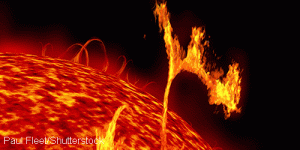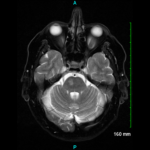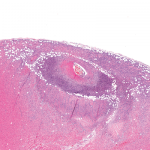 A new study suggests that geomagnetic activity from the sun may contribute to autoimmune disease. Simon Wing, senior staff physicist at Johns Hopkins University in Laurel, Md., and colleagues investigated whether measures of solar cycles correlated with the incidence of giant cell arteritis (GCA) and rheumatoid arthritis (RA) in a single county in southern Minnesota. The investigators found that disease incidence rates vary with the solar cycle; GCA incidence peaks one year after solar maximum, and RA incidence peaks approximately six years after solar maximum. The results of the data analysis were published in BMJ Open.1
A new study suggests that geomagnetic activity from the sun may contribute to autoimmune disease. Simon Wing, senior staff physicist at Johns Hopkins University in Laurel, Md., and colleagues investigated whether measures of solar cycles correlated with the incidence of giant cell arteritis (GCA) and rheumatoid arthritis (RA) in a single county in southern Minnesota. The investigators found that disease incidence rates vary with the solar cycle; GCA incidence peaks one year after solar maximum, and RA incidence peaks approximately six years after solar maximum. The results of the data analysis were published in BMJ Open.1
Physicists measured the geomagnetic effects of the sun on the Earth in multiple ways. Two measures of this activity are the AL index and F10.7. The AL index reflects geomagnetic activity and can serve as a proxy for the westward auroral electrojet. AL has a major periodicity of approximately 10 years and a secondary periodicity of 4–5 years. The F10.7 index is a measure of solar radiation at 10.7 cm and, thus, serves as a proxy for solar extreme ultraviolet radiation.
Prior to the study, investigators noted that the major and minor AL periodicities coincide with incidences of GCA and RA. The coincidence led researchers to suggest that geomagnetic activity may underlie both the temporal and spatial variations in disease incidence. In their study, Mr. Wing and colleagues reported a highly significant correlation between GCA incidence rate and AL. In contrast, the correlation between incidence of GCA and F10.7 was statistically significant, but not strong. The researchers noted a minimum of 0–1-year lag time in the correlation between the GCA incidence rate and AL, and concluded that additional factors may be influencing the incidence of GCA.
When the investigators evaluated the relationship between RA and the two geomagnetic parameters, they found that it was more complex than the relationship of GCA to the parameters. Although there was a highly significant correlation between RA incidence and AL, the lag time was 5–7 years. The researchers also raised the possibility that peaks of geometric activity that occur in the spring and fall might play a role in the onset of GCA and RA.
After establishing a temporal association between geomagnetic activity and disease incidence, the research team investigated whether geomagnetic activities, such as auroral electrojets, play a role in the spatial distribution of GCA and RA. They did this in response to epidemiological data, noting that the GCA and RA incidences have an east-west skew in geographic coordinates—with disease incidence increasing with increasing geographic latitude. Although some have hypothesized that Vitamin D deficiency may result in a higher incidence of RA in populations at a distance from the equator, the Vitamin D hypothesis does not account for the reported east-west skewing.


